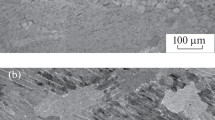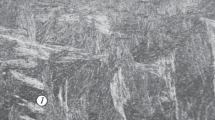Abstract
We studied the mechanism and the kinetics of corrosion-fatigue fracture of titanium alloys with the use of electrochemical methods: changes in the electrolytic potential E during deformation of the specimens (relations E vs. log N and E vs. ΔK) and external polarization (relations E pol vs. ΔK). We investigated the electrochemical processes on a newly formed surface during the time (τ = 5 msec) of its interaction with sodium chloride solutions of different concentrations (0.1, 0.5, 1.0, and 1.5N NaCl solutions). The main stages of corrosion fatigue of titanium alloys of different structural and phase states were identified on the basis of correlation changes in the surface and the electrolytic potential. We showed that the newly formed surfaces of these alloys possess all properties of the material that can pass to a passive state. Activation of the surface of cyclically deformed alloys is accompanied by a significant discharge of the electrolytic potential (−1.2 V) and a sharp increase in the current (159 A/m2). Repassivation is characterized by a three-stage change in both the potential and current. The characters of changes in the curves current vs. time of nondeformed and cyclically deformed alloys are identical, but the current decreases more rapidly in the last case.
Under conditions of plane strain, the dependence of the stabilized value of the electrolytic potential E st on ΔK is linear. The alloy structure and the solution concentration make it stronger or weaker. An increase in the role of the electrochemical factors under conditions of corrosion fatigue was proved in studying the efficiency of electrolytic protection: during cathodic polarization, one can completely suspend the process of corrosion-fatigue crack growth. Finally, we analyzed the kinetics and the mechanism of corrosion-fatigue fracture of titanium alloys.
Similar content being viewed by others
REFERENCES
V. I. Pokhmurskii, Corrosion Fatigue of Metals [in Russian], Metallurgiya, Moscow (1985).
A. B. Vainman and R. K. Melekhov, “Hydrogen embrittlement of articles of high-pressure steam boilers,” in: VINITI Series in Corrosion and Rust Protection [in Russian], Vol. 14, VINITI, Moscow (1988), pp. 123–173.
O. N. Romaniv, “New approaches to the evaluation of corrosion fatigue of metals,” in: VINITI Series in Corrosion and Rust Protection [in Russian], Vol. 16, VINITI, Moscow (1990), pp. 55–88.
M. Pourbaix, Atlas of Electrochemical Equilibria in Aqueous Solution, Pergamon, New York (1966).
H. H. Uhlig and R. W. Revie, Corrosion and Corrosion Control: An Introduction to Corrosion Science and Engineering, 3rd Ed., Wiley, New York (1985).
L. I. Freiman, V. A. Makarov, and I. E. Bryksin, Potentiostatic Methods in Corrosion Investigations and Electrolytic Protection [in Russian], Khimiya, Leningrad (1972).
V. I. Pokhmurs'kyi and M. S. Khoma, “On the efficiency of investigations under conditions of the corrosion fatigue of metals,” Vopr. Khim. Khim. Tekhnol., Ser. Élektrokhimiya, No. 1, 272–274 (1999).
V. I. Pokhmurskii and O. S. Kalakhan, “Kinetics of the electrolytic potential under conditions of corrosion fatigue and corrosion-fatigue crack growth in titanium α- and ( α + β)-alloys in a sodium chloride solution,” Fiz.-Khim. Mekh. Mater., 17, No. 2, 3–10 (1981).
O. S. Kalakhan, “Electrochemistry of corrosion-fatigue processes in titanium alloys,” in: Bull. Lviv Univ., Ser. Chem. [in Ukrainian], Issue 42 (2002), pp. 175–178.
O. S. Kalakhan and V. I. Pokhmurs'kyi, “Corrosion and corrosion crack resistance of PTZV titanium alloys in ammonia-water mixtures,” Fiz.-Khim. Mekh. Mater., 37, No. 5, 31–44 (2001).
V. I. Pokhmurs'kyi and O. S. Kalakhan, “Effect of polarization on fatigue crack growth in a titanium pseudo-α alloy in an alka-line medium,” Fiz.-Khim. Mekh. Mater., 37, No. 2 (Special Issue), 51–55 (2001).
O. S. Kalakhan, “Regularities of the electrochemical properties of titanium alloys during corrosion fatigue,” in: “Modern Problems of the Mechanics of Materials: Physicochemical Aspects and Diagnostics of Properties” (Lviv, June 4–7, 2001) [in Ukrainian], Shevchenko Sci. Soc., Lviv (2001), pp. 94–95.
O. S. Kalakhan, “Influence of the deformation of titanium alloys on the kinetics of formation of protective oxide films,” Fiz.-Khim. Mekh. Mater., 38, No. 3 (Special Issue), Vol. 1, 172–176 (2002).
V. I. Pokhmurskii, O. S. Kalakhan, and N. Ya. Yaremchenko, A Method of Fatigue Tests of Materials [in Russian], USSR In-ventor's Certificate No. 954859, Publ. 30.08.82, Bull. No. 26 (1982).
F. M. Mikheeva, F. P. Frolov, G. M. Florianovich, et al., A Device for Electrochemical Measurements on the Surface of a Specimen Being Permanently Renewed [in Russian], USSR Inventor's Certificate No. 570828, Publ. 31.07.73, Bull. No. 32 (1973).
O. S. Kalakhan, “Effect of the nature of contacting materials on the cyclic strength of VT14 titanium alloy at the imposition of elements of sliding friction,” in: Deposited at VINITI, No. 4423-80, Moscow (1982), pp. 71–73.
L. I. Antropov, Theoretical Electrochemistry [in Ukrainian], Lybid', Kiev (1993).
T. R. Beck, “Reaction and kinetics of newly generated titanium surfaces and relevance stress corrosion cracking,” Corrosion, 30, No. 11, 408–414 (1974).
I. L. Rozenfel'd and K. I. Afanas'ev, “An investigation of the electrochemical behavior of newly formed surfaces of metals in electrolyte solutions,” in: VINITI Series in Corrosion and Rust Protection [in Russian], Vol. 7, VINITI, Moscow (1978), pp. 42–59.
Yu. S. Ruskol, Titanium Structural Alloys in the Chemical Industry: Handbook [in Russian], Khimiya, Moscow (1989).
N. D. Tomashov, Titanium and Titanium-Base Corrosion-Resistant Alloys [in Russian], Metallurgiya, Moscow (1985).
J. F. Knott, “Effect of the medium on crack growth under monotone and cyclic loading,” in: Corrosion Fatigue of Metals [in Russian], Naukova Dumka, Kiev (1982), pp. 7–38.
V. A. Marichev and V. V. Lunin, “On the ambiguous influence of cathodic polarization on the corrosion cracking of titanium al-loys,” Zashch. Met., 16, No. 6, 674–683 (1980).
I. V. Gorynin and B. B. Chechulin, Titanium in Machine Building [in Russian], Mashinostroenie, Moscow (1990).
K. R. Gorbachevskaya and O. S. Kalakhan, “A study of the electrochemical reactions on a titanium alloy by the rotating disk electrode method in ammonia-water media,” Fiz.-Khim. Mekh. Mater., 23, No. 3, 25–29 (1987).
I. M. Dmytrakh and V. V. Panasyuk, Effect of Corrosive Media on the Local Fracture of Metals near Stress Concentrators [in Ukrainian], Karpenko Physicomechanical Institute, Ukrainian Academy of Sciences, Lviv (1999).
Author information
Authors and Affiliations
Rights and permissions
About this article
Cite this article
Kalakhan, O.S. Kinetic Regularities of the Electrochemical Processes of Corrosion Fatigue in Titanium Alloys. Materials Science 39, 615–628 (2003). https://doi.org/10.1023/B:MASC.0000023500.42249.2b
Issue Date:
DOI: https://doi.org/10.1023/B:MASC.0000023500.42249.2b




